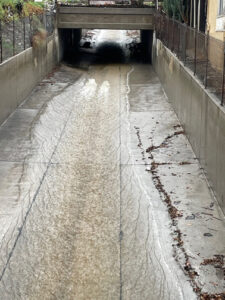
By Mary O’KEEFE
This storm that since Sunday moved through the state is a real storm. On social media there is this thing where a recoded voice talks about how bad it is for Californians: “It’s raining and the sun isn’t shining.” The first time I saw this I thought self-deprecation was a little funny … but then not so much. This is a real rain. There is real flooding and all this rain creates a real danger – especially with mudslides.
So yeah, from someone who was not born and raised here, and someone who has lived in other states, California is pretty weather perfect. I mean you can go to the mountains and snowboard or sled, and then, on the same day, go to the beach. And for the most part I agree with Randy Newman (maybe a little tongue in cheek): “It’s just another perfect day. I love LA.”
The myth that Californians don’t know real weather is just not a reality. This rainstorm can rival any rainstorm I have seen in Iowa or Missouri. That being said, California has always had its own way of identifying its natural disasters and/or weather. An earthquake is a “shaker” and the rain system that comes from Hawaii is the “Pineapple Express.”
There is some debate on who exactly coined the phrase “Pineapple Express.” Meteorologists in Washington State and California have claimed the mantle “first to use” but it was first used in the 1960s and was a way to describe an atmospheric river that originates in the Pacific near Hawaii then travels to California.
“Pineapple Express, so dubbed because of the fruit being a symbol of the U.S. Island chain,” according to statista.com.
But now the term “atmospheric river” is on every weather report. It seems lately we are either expecting one, just missed one or are in the middle of one.
The term atmospheric river was first used in 1994 to describe atmospheric water vapor being transported across the mid-latitudes … although there is still a debate about its exact meaning.
Atmospheric rivers are relatively long, narrow regions in the atmosphere, like rivers in the sky, that transport most of the water vapor outside of the tropics. While atmospheric rivers can vary greatly in size and strength, the average atmospheric river carries an amount of water vapor roughly equivalent to the average flow of water at the mouth of the Mississippi River, according to NOAA.
The Pineapple Express is a strong atmospheric river. From Dec. 10-22, 2010 a series of atmospheric rivers fueled the strong winter storms that battered the U.S. West Coast from western Washington to Southern California. This series of storms produced 11 to 25 inches of rain in certain areas and contributed to the snowpack in the Sierra, which received 75% of its annual snow by Dec. 22, according to NOAA.
“The phenomenon of atmospheric rivers is fed by the El Niño conditions that have taken over the climate of the Americas again since mid-2023. Atmospheric rivers are plumes of moisture that extend from the tropics all the way to more northern reaches and are made possible by El Niño-related changes in the jet stream air currents that circle the globe. Normally, these jet streams travel in a westerly direction but under certain conditions plumes can escape and travel long distances, bringing tropical rains to more moderate locales,” according to statista.com.
Just like in every medium, meteorologists want that phrase that captures the imagination as well as explains conditions. It is the same as when I heard JPL’s Marc Raymond mention “ion propulsion” when I attended a seminar. Every Trekkie in the audience sat up when we heard this; most of us civilians didn’t exactly know how ion propulsion worked but we knew “Star Trek” vessels traveled really fast with it. [Of course, I was going to bring “Star Trek” into this.] So having a catch phrase like “atmospheric river” helps non meteorologists get a visual of a huge amount of rain over us, like a river. And polar vortex is a much more creative way of telling us a cold and snowy storm is on the way. It’s better than saying “a large area of low pressure and cold air surrounding both of the Earth’s poles,” according to the National Weather Service.
It’s all in the presentation – atmospheric river/Pineapple Express – whatever you call it, we have had rain, lots of rain, and there have been flooding and traffic collisions in addition to one thing that the Midwest doesn’t have to deal with: high surf.
And just how much rain have we received?
The Pineapple Express/atmospheric river we just faced dropped 5.72 inches of rain recorded at Hanson Dam and 5.84 inches in Burbank.
Downtown Los Angeles registered 8.51 inches of rain, which is the second wettest three-day total since they began recording in 1877, according to Mike Wofford, meteorologist with NOAA.
The rain was expected to linger through late Wednesday night/early Thursday morning but we should see dry skies at least until next Thursday. Temperatures will still be on the cool side with highs in the upper 50s/mid 60s.
This storm has brought much-needed snowfall as well, with Mountain High, Wrightwood receiving 42 inches of snow.
